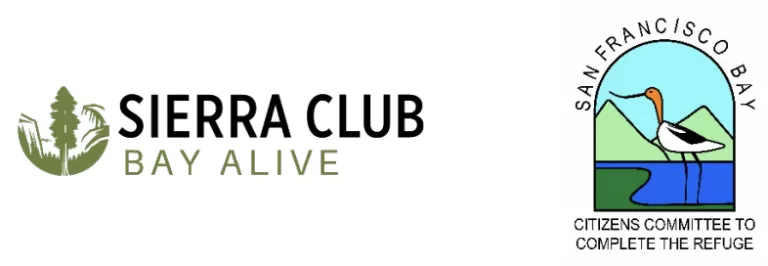
Letter sent via electronic mail only
Jaclyn Perrin-Martinez Delivered 10/18/2024
SF Bay Conservation and Development Commission
Email: jaclyn.perrin-martinez@bcdc.ca.gov
Re: Comments on Public Draft of the Regional Shoreline Adaptation Plan
Dear Ms. Perrin-Martinez,
The Sierra Club and the Citizens Committee to Complete the Refuge appreciate the opportunity to provide comments on the public draft of the Regional Shoreline Adaptation Plan (RSAP). Several of us have been on the Advisory Committee as well as some subcommittees, and are deeply appreciative of staff’s response to our concerns and suggestions. The rapid time frame required by SB 272 for so complex a document did not lend itself to full discussion of all the elements in the RSAP Advisory Committee process, so we have endeavored to provide more comprehensive feedback by way of this letter.
We do want to express our appreciation that the draft RSAP recognizes the importance of the Bay itself, not just its beauty, but also its biodiverse ecosystems and the many ways our communities depend upon the benefits provided by a healthy and thriving Bay. It is essential to preserve a healthy Bay in the face of sea level rise, not only for the Bay itself, but also for our communities’ health and for the economic health of the Bay Area. Similarly, the wellbeing of our frontline, environmental justice communities is crucial to the thriving and resilient Bay Area. We appreciate the comprehensive integration and application of the Equity Assessment Standard throughout the RSAP.
We start our letter with a narrative section that discusses the following:
- problems with the structure of the RSAP,
- the need to more fully explain why it is essential to use NNBS (Natural and Nature Based Solutions) for sea level rise adaptation in order to preserve the Bay’s health and in explaining why it is essential to make Bay health a core consideration throughout the RSAP and at every step of planning and implementation of Subregional Shoreline Adaptation Plans (SRSAPs),
- the need for the RSAP to recognize ecosystem health and NNBS in all Strategic Regional Priority (SRP) topic areas and Strategic Plan Elements,
- the insufficiency of the RSAP’s guidance and requirements relating to how SRSAPs should address contaminants and how groundwater issues threaten to exacerbate the contaminant issue,
- the lack of metrics or measurable goals to inform the development of SRSAPs and provide benchmarks to measure the degree to which we are achieving region-wide goals of holistic adaptation to sea level rise and the need to ensure adaptation projects are captured in the
- EcoAtlas - Section G1B should clarify that the “Regional Project Database” is the SFEI EcoAtlas database.
- Attachment A is entitled Glossary in which we suggest additions to your current RSAP Glossary. While your Glossary provides some help to readers in explaining terms with which they are not familiar, there are many others (even Natural and Nature Based Solutions, NNBS) that are not mentioned. We make some suggestions to help expand the Glossary and make it more useful to readers and planners.
- Attachment B is a spreadsheet of our comments on specific parts of the RSAP. Considering the complexity of the issue and the short time frame, it is not surprising that there will be grammatical and editorial issues. Many of these comments address such issues. But these can be significant if the error can lead to confusion or misinterpretation. Other comments refer to suggested edits for specific sections of the Plan and Guidelines.
Again, thank you for the opportunity to submit these comments and we congratulate the staff and BCDC for emphasizing the importance of a healthy Bay as well as centering equity in all elements of the RSAP.
Please note that unless specifically defined otherwise, when we use the term “sea level rise” we are including groundwater rise and storm surge, i.e. total water levels.
- The Confusing Structure of the RSAP
Our organizations are well aware of the difficult task that has been assigned to you by SB 272. The complexity required to align all the elements of our communities into a single plan that will adequately respond to the threats of sea level rise is something that is unprecedented. Each element of the One Bay Vision, such as transportation, infrastructure, and housing, has tremendous complexity in itself and requires its own extensive planning processes. The unique threats posed by sea level rise require a crucial addition to this complexity by adding the recognition that the Bay itself and its habitats play a significant role as part of our greater infrastructure, providing innumerable essential economic and environmental benefits and services to our communities, and therefore must be included as both vulnerable assets and vital tools in any sea level rise adaptation planning effort. It is no surprise then, that the public draft of the RSAP is just as complex as these issues. Equally challenging is the fact that with complexity comes the opportunity for confusion from which we believe the RSAP suffers.
The complexity and confusion of the RSAP are understandable. It is essential to provide the context and rationale for the requirements of the SRSAP Guidelines and since they address all of society’s physical elements, its infrastructure and environment, as well as its equity issues, there is a lot of context to be described and, understandably, some need for redundancy. Unfortunately, between the narrative, highlighted boxes, and checklists, it is easy to lose track of the distinctions between aspirations, requirements, and shorthand summaries of requirements. As the RSAP moves through the “Visioning” background it is not clear whether the bullets in the Vision boxes are “requirements” for a SRSAP. For example, on page 50 in the “One Bay Vision“ box there is a bullet, “Identify and facilitate opportunities for ecosystems to migrate landward to support and enhance natural adaptation processes.” It is not clear however, whether this bullet is a requirement and not just a vision. In fact, it is not until under Adaptation Strategies, pages 145 and 150, that it is made clear that a SRSAP should identify locations where marsh migration may occur and if possible, plan for that act.
To provide clarity, in Section 2 of the RSAP, we suggest that for every “One Bay Vision” box, and for every “SRP Adaptation Standard” box either the bullets within that box (One Bay Vision) or the text of the SRP box have accompanying hyperlinks that take readers to the Assets, Requirements and Standards pertinent to that bullet or text. There, readers can find elucidation regarding what that Vision or SRP statement requires for inclusion in the SRSAP, i.e. which Assets, Requirements and Standards need to be addressed. That would provide assurance to a reader that those bullets indeed require actions and that there are instructions on how to incorporate those actions into the SRSAP.
Similarly, in Section 3, each Standard in the Adaptation Standards Matrix Checklist should have hyperlinks to the full text discussion of what each Standard entails. For example, in the Matrix Checklist, Standard #4 is described as “Improve Bayland Habitats and facilitate their long-term survival,” and the Checklist Submittal Requirements are, “Improve Baylands habitats and facilitate their long-term survival.”
But the full text of the Standard on pg. 145 goes much further:
Areas along the Bay shoreline with existing Baylands habitats must protect, restore, and/or enhance these habitats to meet regional habitat goals. Protection means continuing the functions and services the habitats provide as sea levels rise over time. Restoring means bringing back functions and services where they once existed ... This can be achieved by ensuring that the spatial extent, distribution, abundance, and conditions of habitat types can be maintained or improved as sea levels rise; identifying and designating marsh migration space and upland transition zones; and/or identifying opportunities to connect Baylands habitats ...
The full text brings in the concepts of marsh migration, enhancement and restoration as required objectives if feasible, not issues that urban planners usually think about. It is important that planners can easily find the full text so that they do not ignore some of their obligations under that Standard. Thus, we believe that all checkboxes should have hyperlinks to the text that elucidates the purpose of each checkbox.
For the structure of the RSAP we believe that while it is quite reasonable to have detailed explanations of the various requirements for the Subregional Plan Elements and for all of the other checklists, the narratives do make it difficult to keep track of all these assets, requirements and standards. We believe it would be very useful to aggregate all of the checklists, standards, assets and requirements in a single appendix or supplement that has no narrative, but is just a list of all of these parts of the SRSAP that are required in the creation of the final submittal. Of course, the hyperlinks will take them to the explanatory texts.
Finally, we believe that the Glossary needs to be greatly expanded. For example, Natural and Nature Based Solutions is a relatively new term and most people have no idea what it refers to and what it means. We provide suggested additions in Attachment A.
- Why should communities have to worry about the Bay ecosystem and implement NNBS?
Particularly for the Ecosystem Health and Resilience portion of the RSAP, we are dealing with issues and terminology that are new to the planning world, for example Natural and Nature Based Solutions (NNBS). Most planners will not have studied this subject as part of their planning curricula. Many local elected officials have not dealt with this subject, and do not have an understanding of the issues involved or the many co-benefits that the use of NNBS can provide for their communities and the environment. For this reason, RSAP Sections 1 and 2 serve an essential educational function. However, as currently written they are not sufficient to achieve that task. Without proper education on the importance of NNBS, we worry planners will not properly capitalize on the opportunity to implement and expand these assets wherever possible, ultimately undermining the purpose and vision of the RSAP.
While Bay Area residents are clearly dedicated to a healthy Bay, as evidenced by the votes for creating and funding the Restoration Authority, SB 272’s requiring local governments to join in the effort to protect, restore and expand Bay habitats through the SRSAPs is a significantly larger step forward. Local governments may ask why there is a need to consider the ecological health of the Bay through the use of NNBS and the RSAP needs to provide the answer, at least briefly but comprehensively. The RSAP needs to explain that protecting and expanding the Bay’s habitats not only ensures the continued existence of a healthy Bay, but the continued existence of healthy and thriving Bay Area communities. The RSAP should underscore the fact that our Bay’s wetlands and other habitats actually provide significant economic benefits to our communities beyond ecological health.
For example:- the California Water Quality Monitoring Council states, “Wetland vegetation works as a sediment trap and locks up nutrients and contaminants, thereby preventing concentration downstream that can result in algal blooms or human health hazards ... wetlands act as natural water purifiers, filtering and sequestering sediment and pollutants. Two-thirds or more of all the fish and most of the shellfish we consume are dependent on coastal wetlands...” (https://www.mywaterquality.ca.gov/eco_health/wetlands/extent/types/services.html#:~:text=Wetland%20vegetation%20works%20as%20a,blooms%20or%20human%20health%20hazards.)
- Bay Area Water treatment plants are already being asked to upgrade their processes in order to remove more nutrients to help avoid Harmful Algal Blooms. Expanded Bay wetlands will help reduce that threat and the cost imposed on Bay Area residents to achieve that goal. Expanded wetland acreage will help grow our fishing industry as wetlands act as nurseries for many of our fisheries (fish, crabs, oysters, etc.), producing more jobs.
- Tourism is one of the Bay Area’s key industries and a living Bay, with seals, whales and birds, is one of the attractions that sustains this industry . Current data estimates that around 30% of tourists who visit the Bay Area take at least one ferry ride.
- Our Bay’s wetlands help moderate the Bay Area’s temperature, an essential benefit in a climate change world. The list continues.
- Our Bay’s shoreline habitats play a significant role in reducing the impacts of storm surges, acting as barriers that protect communities from flood inundation during high tides. This is why the historically conservative US Army Corps of Engineers is now advocating for the use of Natural and Nature Based Features (the equivalent of Solutions), “Natural and Nature Based Features are landscape features that are used to provide engineering functions relevant to flood risk management, while producing additional economic, environmental, and/or social benefits...” (https://ewn.erdc.dren.mil/natural-nature-based-features/).
- Tidal marsh vegetation sequesters carbon at a rate ten times greater than tropical forests, thus helping in the fight against climate change and sea level rise itself. All these actions not only protect our communities but also provide immense economic benefits, reducing the need to implement other measures to address these issues.
In other words, the Bay’s shallow water habitats play a crucial role in supporting our communities.
We are, again, very appreciative that staff has recognized all of this and have, in the latest draft RSAP,provided some important requirements for the protection and expansion of Bay shoreline habitatsand some brief explanations of why this is important. However, we believe that this subject needssignificantly greater emphasis. The following edited pages from the RSAP provide several examples ofhow text can be inserted into the document to provide greater support in explaining the benefits ofNNBS.
Suggested revised page 12
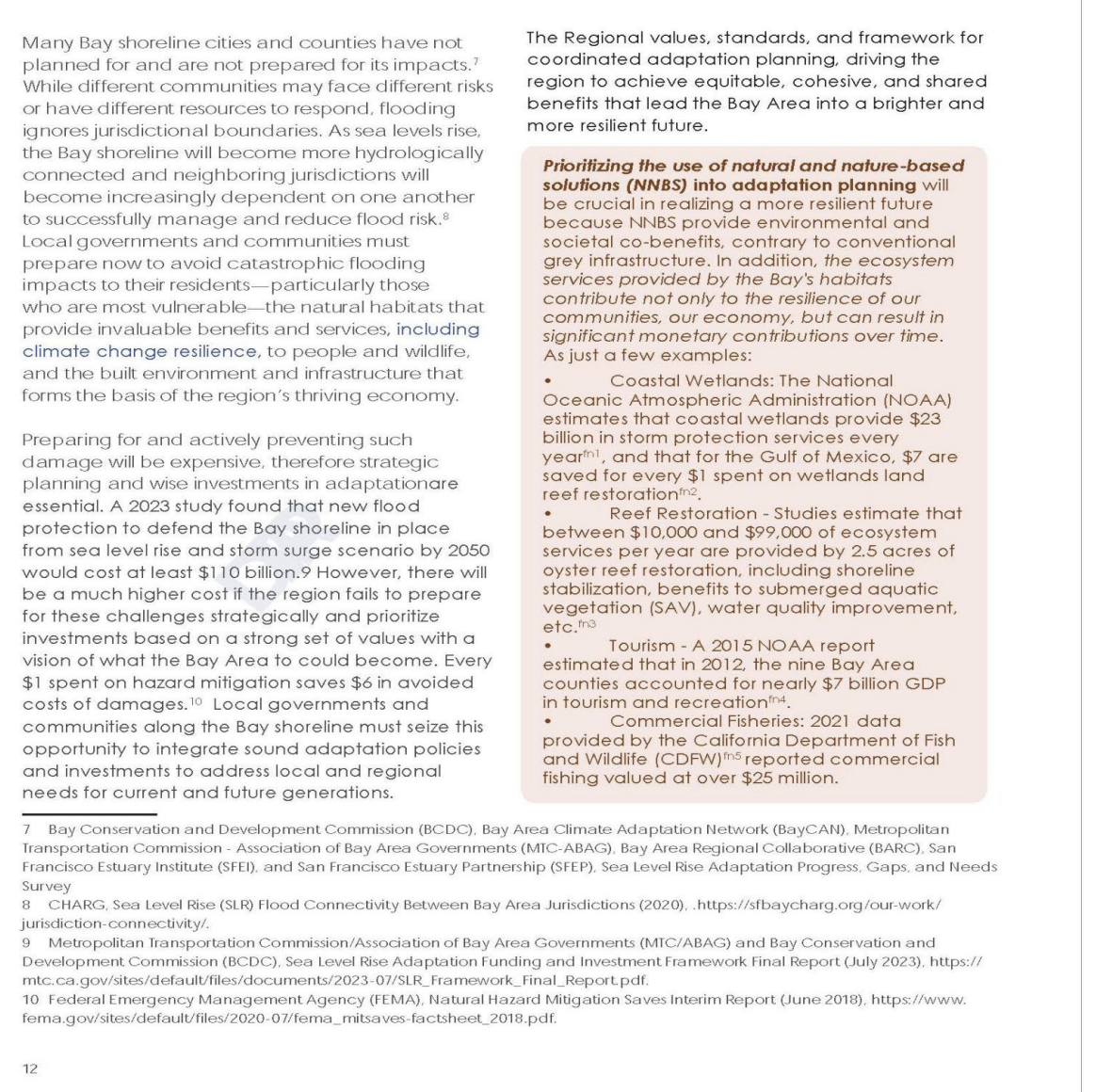
FN1 – Cited by NOAA J. Foster, A. Lowe, S. Winkelman, 2011. The Value of Green Infrastructure for Urban Climate Adaptation, Center for Clean Air. Economic Geography 2(1): 31-54. htps://wrrc.arizona.edu/sites/wrrc.arizona.edu/files/green_infrastructure.pdf
FN2 – Cited by NOAA Reguero BG, Beck MW, Bresch DN, Calil J, Meliane I (2018). Comparing the cost effectiveness of nature-based and coastal adaptation: A case study from the Gulf Coast of the United States. PLoS ONE 13(4): e0192132. htps://doi.org/10.1371/journal.pone.0192132
FN3 - Jonathan H. Grabowski, Robert D. Brumbaugh, Robert F. Conrad, Andrew G. Keeler, James J. Opaluch, Charles H. Peterson, Michael F. Piehler, Sean P. Powers, Ashley R. Smyth, Economic Valuaon of Ecosystem Services Provided by Oyster Reefs, BioScience, Volume 62, Issue 10, October 2012, Pages 900–909, htps://doi.org/10.1525/bio.2012.62.10.10
FN4 - NOAA. Office for Coastal Management. "Fast facts. Natural Infrastructure." htps://coast.noaa.gov/states/fast-facts/natural-infrastructure.html
FN5 – NOAA. The National Significance of California’s Ocean Economy. 2015. htps://coast.noaa.gov/data/digitalcoast/pdf/california-ocean-economy.pdf
Suggested revised page 28
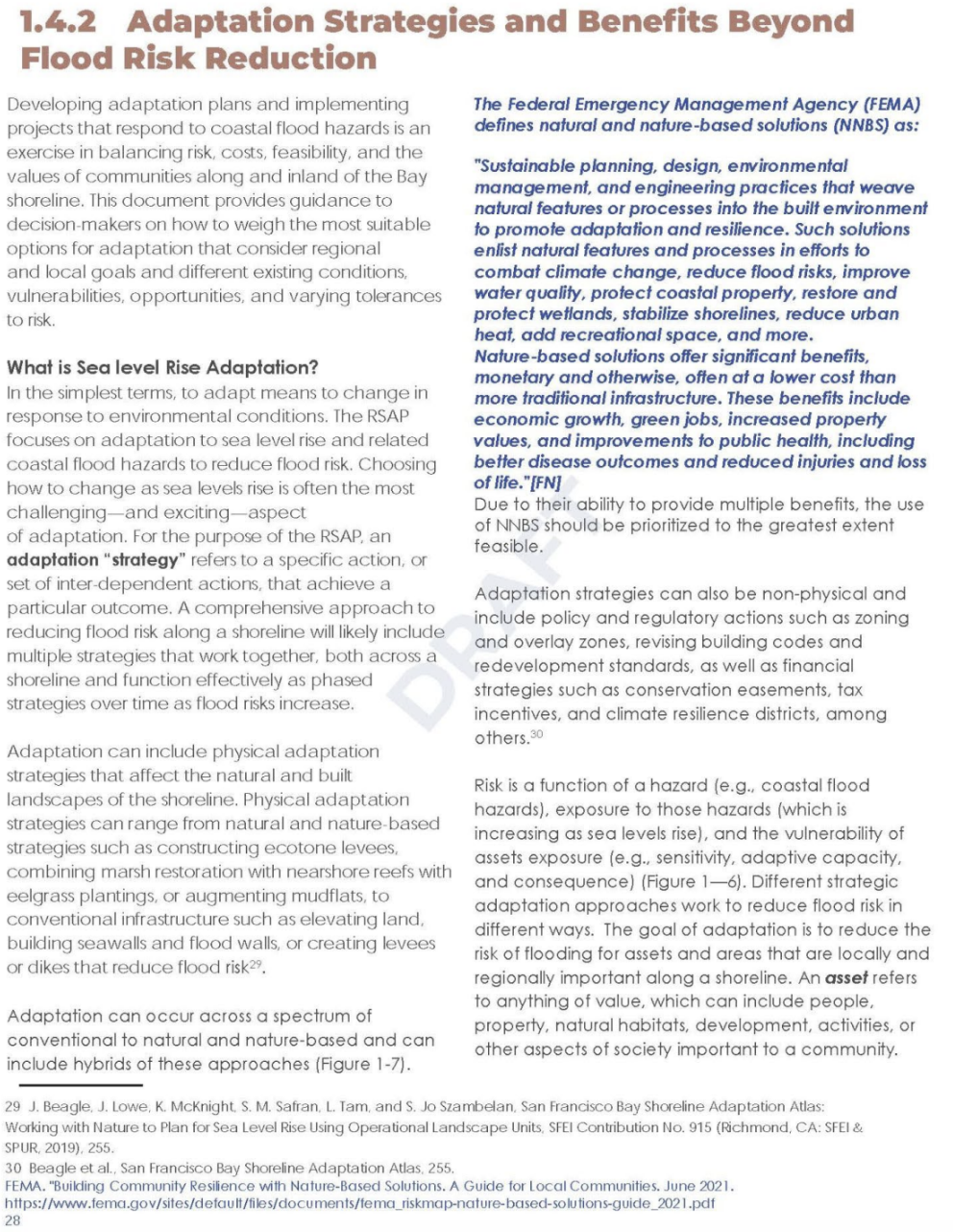
Suggested revised page 29
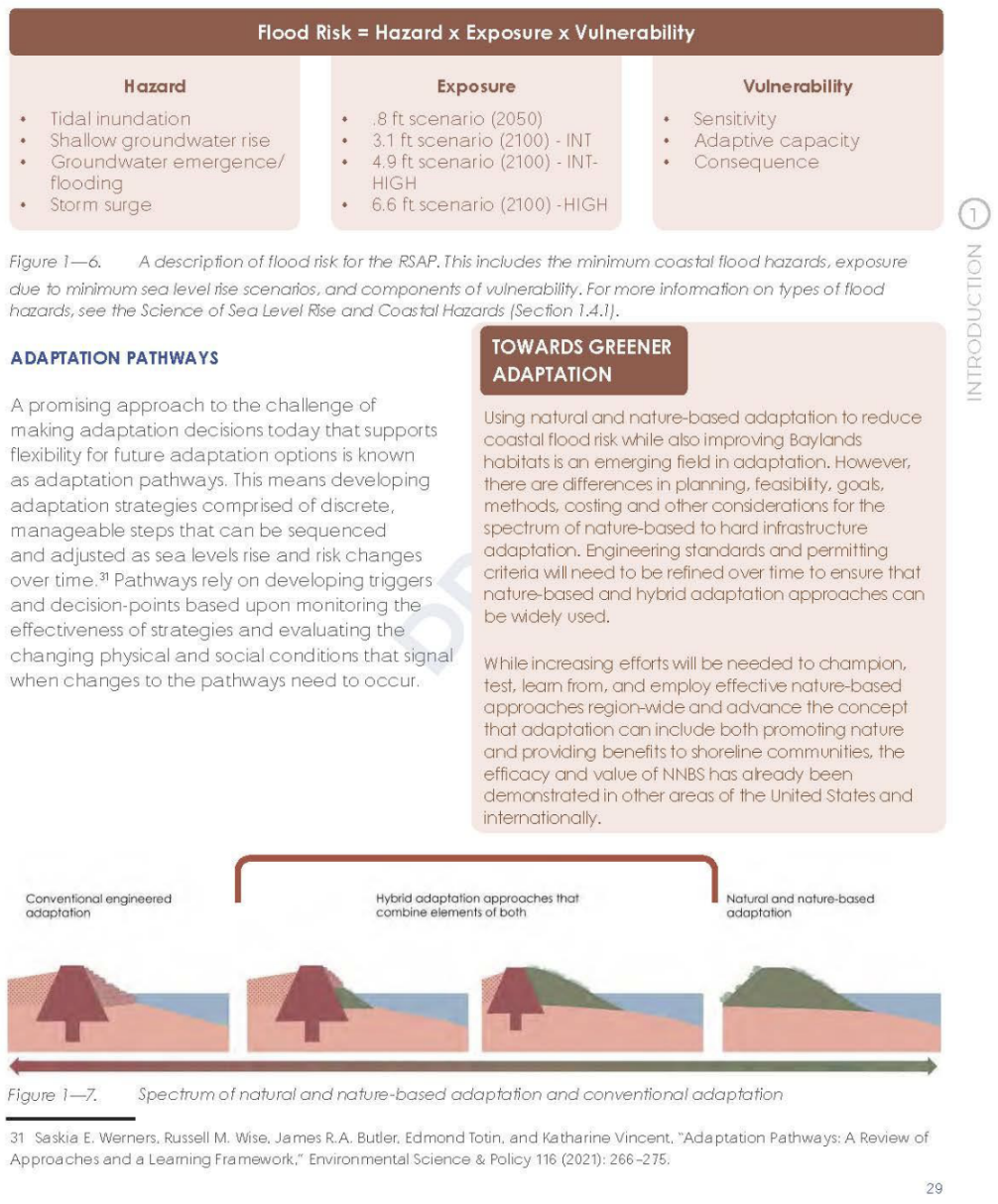
Suggested revised page 33
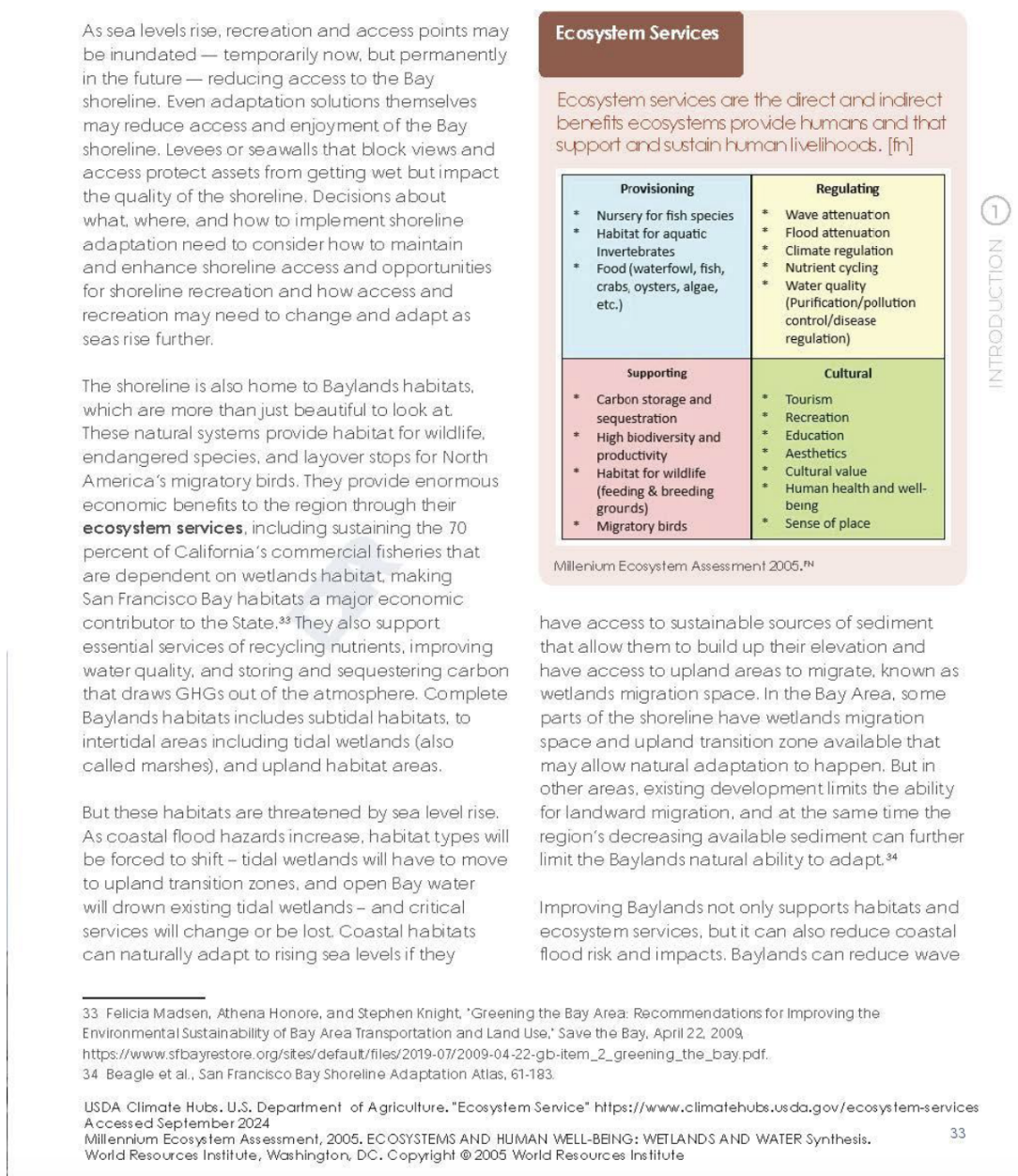
- Need for stronger universal emphasis on use of NNBS
We are very appreciative that NNBS does appear in nearly all of the SRP Topic Area discussions, if only as a single phrase. However, more than how often the term is used, where the term is situated can be even more important. For example, Topic Area 2.3.8, “Collaborative Governance...” includes a quote from the One Bay Vision that includes NBS, “...Ensure local and regional governments collaborate among themselves and with others to address shared flooding risk, identify multi- benefit adaptation opportunities including nature-based solutions....” However, the SRP Box stating requirements for that Topic Area does not mention NBS, and when one arrives at the Adaptation Strategy Standards text as the requirement for that issue (#6, pg. 146), NBS does not appear. While we recognize that NBS is mentioned elsewhere, if one is only looking at how to proceed with collaborative efforts to avoid flooding, it would be quite possible to think that for this issue NBS need not be considered. While it might have been mentioned in the Vision Statement, the failure to appear in the Specific SRP means it may not be read as an Adaptation Strategy Standard that must be considered.
As well, while NNBS is discussed primarily in terms of the living shoreline being an asset, it is not really discussed in terms of being a tool or method to be used to protect other assets. As mentioned earlier, city planners are not well versed in using these tools, and don’t necessarily understand how they can be deployed or even that it is possible that their use can be cost efficient in the long run. It is important to stress the possibilities of NNBS throughout the various sections, especially when talking about planning adaptation or in the various checklists.
- Strengthen Discussion and Requirements regarding Contaminants and Groundwater Rise
The related issues of contaminants and groundwater rise, while addressed in the RSAP, are also not given the attention they demand. The RSAP’s contamination Standard is too narrow, both in terms of impact and applicability. Specifically, the RSAP Standard to reduce contamination risks in Environmental Justice communities (Adaptation Strategy Standard 11) seems only to address contaminant issues “due to flooding,” omitting the substantial new contamination risks posed by subsurface movement of shallow groundwater. Additionally, there appears to be no contamination Standard at all pertaining to non-EJ communities. Our organizations greatly appreciate and support the RSAP process in its attempt to address Environmental Justice and equity issues in nearly every Element, Requirement and Standard. However, contamination risks associated with sea level rise are not restricted to these communities, so we ask that this Standard be expanded to require all communities to develop strategies for contamination cleanup and risk reduction related to both flooding and subsurface shallow groundwater movement.
In addition to expanding the RSAP’s approach to contamination Standards, Section 2.3.7, (Shoreline Contamination) should require, not merely recommend, assessment of brownfield sites, buildings and/or land use that contain hazardous materials, and oil spill risks, especially in EJ communities, expand Adaptation Strategy Standard 16 (Incorporate climate-responsive standards and codes for adaptive design) to specifically include contamination risks, and raise the SLR exposure threshold to be assessed from the 2050 scenario to the 2100 scenario of 6.6 feet.
Groundwater rise poses unique challenges whether emergent or non-emergent and shallow. Besides the risks to underground or aging infrastructure it may also increase the risk of mobilizing contaminants from many hundreds, if not thousands, of toxic sites and landfills surrounding the Bay with negative impacts on public health and Bay water quality and ecosystems. (https://news.berkeley.edu/2023/06/20/rising-groundwater-threatens-thousands-of-toxic-sites-in-the-bay-area/)
The vast majority of toxic sites and landfills have contamination either left in place or are open pits filled with contaminated materials. A “cap” may be placed over the top to prevent spread of contamination, but most often the sides and bottoms of capped sites are not sealed in any way. In some cases, the bottom of the site may rest directly on Bay mud. The presence of a cap may protect the top of the site, but with sea level rise, the threat comes from underneath, by “non-emergent shallow groundwater” that is pushed upwards as sea levels rise. As this water encounters the contaminants in capped sites, toxins are mobilized and can be washed out into the Bay or follow the path of least resistance, creating plumes of contaminated groundwater that carry the toxins beneath nearby neighborhoods.
While the RSAP does emphasize the importance of this issue for vulnerable communities, the issue of groundwater and contamination, wherever it occurs, is a potential threat to public health, Bay ecology and the ecosystems that we all depend upon. Therefore, the RSAP needs to require that all communities address this issue. While BCDC and local communities usually are not as responsible for these capped sites as the Department of Toxic Substance Control (DTSC), we urge BCDC to develop stronger language in the RSAP urging DTSC to collaborate with local governments in all SRSAP planning efforts and to propose solutions to the more intractable sites where contaminants cannot be removed and there are no liners for the pits.
Finally, although potentially outside of the scope of BCDC’s SB272 directive, we strongly urge BCDC to take a leadership role in facilitating more responsive action by regulatory agencies to address the contamination concerns of EJ communities, and promoting a legislative and/or regulatory scheme to generate shared, region-wide commitments, coordination and investment to advance contamination cleanup in EJ communities.
- Metrics
While having specific numeric goals may not be appropriate for all SRSAP Elements, it certainly is essential for Ecosystem Health and Resilience. “Regional Goals” are mentioned with some frequency in those sections that deal with this issue as goals that local governments need to assist in reaching if that is feasible as part of the SRSAP. However, nothing in the RSAP language defines the goals. Instead, we have only language that says we should “protect and restore” Bay habitats, with no indication of how much is enough - 1,000 acres? 10,000 acres? 100,000 acres? This type of information is not only essential for the development of Shoreline Adaptation Plans, but also for the evaluation of those plans once submitted, and for assessing whether as a region, the RSAP is helping us achieve regional goals. Without stating what those goals are, how will it be possible to measure the success of the RSAP process at the five- and ten-year review periods? Without being mindful of those goals when developing Shoreline Adaptation Plans, how do we course correct? Given the pressure for continued development of the shoreline, how will we learn from project tracking and mapping that we are not meeting those goals if those goals are not stated? These regionally accepted goals do indeed exist. For example, the habitat goals in the Bay Ecosystem Habitat Goals Report as well as the Sub-Tidal Goals study and the 2022 Implementation Strategy of the San Francisco Bay Joint Venture. Their goals should be incorporated into the RSAP.
This can be achieved by including in Section 2.3.2 Ecosystem Health and Resilience the habitat acreage targets for the region, for example a goal of 100,000 acres for tidal marsh, a figure that was first established by the 1999 Baylands Ecosystem Habitat Goals. Additionally, this section should reference the goals of protection 16,500 acres of estuarine-upland transition zone habitat and 14,000 acres of suitable adjacent uplands habitat, as these areas are most threatened by continued development of the shoreline.
Additionally, we propose a definition of “Regional Habitat Goals” be added to the Glossary (Attachment A):
“Regional Habitat Goals” reflect the target of restoring 100,000 acres of tidal wetlands as identified in the 1999 Baylands Ecosystem Habitat Goals, and the targets of protecting 16,500 acres of estuarine-uplands transition zone habitat and 14,000 acres of suitable adjacent undeveloped or lightly developed uplands habitat, as identified in the 2022 San Francisco Bay Joint Venture Implementation Strategy.
The need for this is made clear in the map provided for Element 2, Ecosystem Health, in which the areas depicted on the map are vague. Local governments will have great difficulty determining which habitats are within their jurisdiction and the extent of their existing and potential acreage. More detailed maps are available. This is particularly important for shoreline areas that have Upland Transition Zones and for those that may provide for wetland migration. While we recognize that the capacity of each jurisdiction to contribute to the habitat goals will vary dramatically, every SRSAP should indicate how much acreage it anticipates it will protect, restore, and enhance. Where deemed infeasible, the SRSAP should explain why.
Also, the need for monitoring all SRSAP’s Projects that are implemented must be emphasized. Otherwise, it will be impossible to determine whether those actions achieve intended goals. We believe that Element F3 could be relabeled “Include an Adaptive Management Program” that would describe the process for monitoring and also for decision-making once monitoring results are presented that may show the need for some realignment of adaptation measures. Element F. should be expanded to include an F.3.c. that requires the plan to identify what entity is responsible for determining and implementing next steps once monitoring data is collected and analyzed and if analysis indicates a need for further actions.
We recommend that page 50, 2.3.2 Ecosystem Health and Resilience be revised as follows:
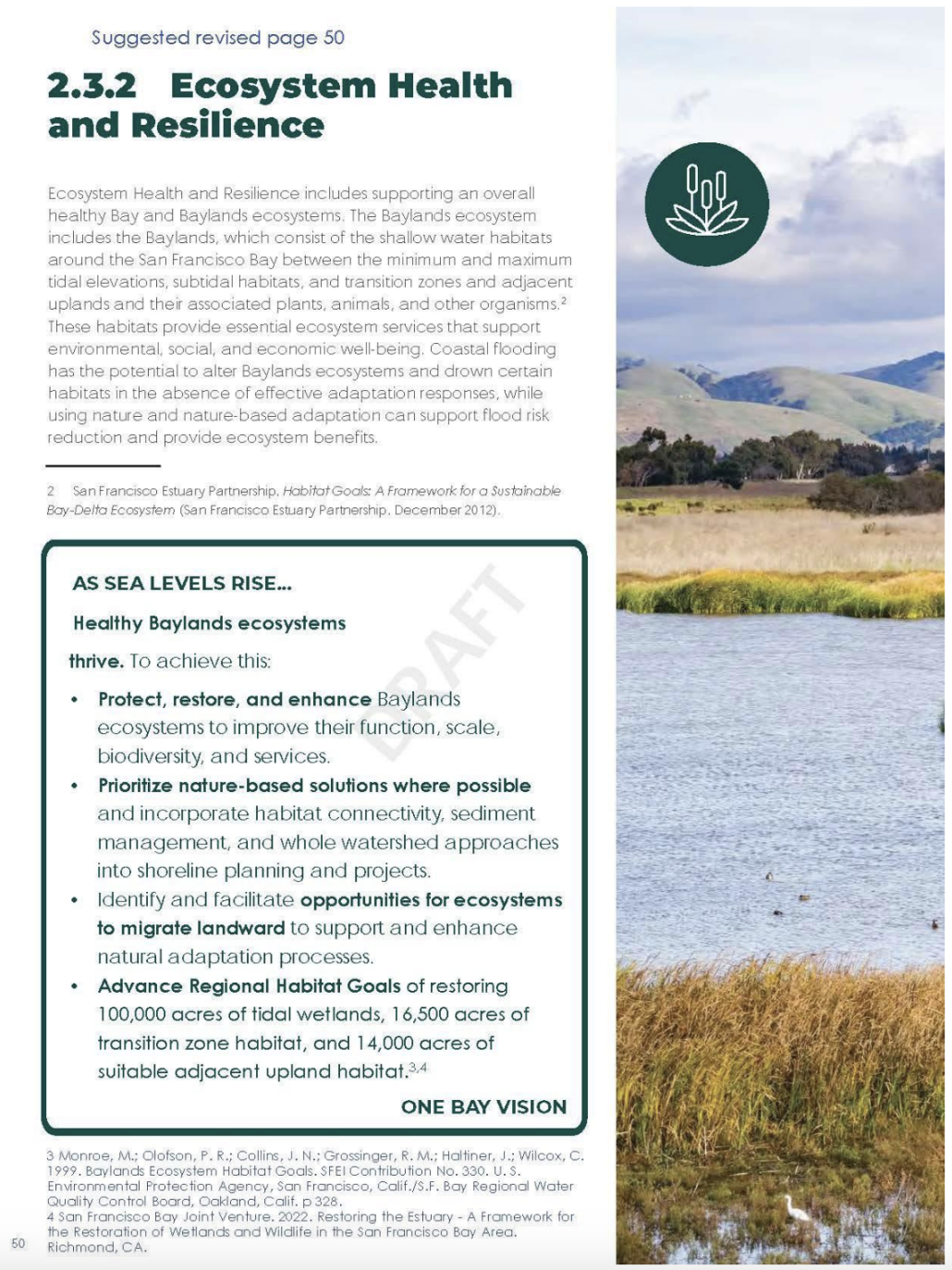
Further discussion of this issue has been provided in the comments submitted by Coordinator Kelli McCune for the San Francisco Bay Joint Venture. We strongly endorse the suggestions presented in that submission, including the need to identify the SFEI EcoAtlas as the “Regional Project Database” described in Element G.1.b.
- Should and Must
We greatly appreciate your elucidation of the uses of “Must, Required and Should” (RSAP, pg. 6):
The terms “must” and “required” are used to denote content that is mandatory to be completed in Subregional Shoreline Adaptation Plans. “Should” means local governments make every attempt possible to meet the information listed. If that information cannot be provided or met, a description of why must be included. All plan requirements and standards are mandatory.
SB 272 was enacted to ensure that the Bay Area (and the coast) addressed sea level rise in a coordinated, collaborative manner that acts to protect all our communities, preserve the Bay’s health and provide vulnerable, under-resourced communities the opportunity to meet all these goals. The Act was needed because otherwise, individual communities would seek their own best interests and not consider all the rest of the Bay’s communities and habitats.
Unless there are clear mandatory requirements, local communities could use the discretion provided by the word “should” to ignore many of the instructions in the RSAP that are designed to, again, result in resilient communities and a healthy Bay.
In so complex a program there will always be conflicts between desired end results. There is no question that compromises will be necessary. Communities will be protected with gray infrastructure where no other alternatives exist. Wetland migration will, hopefully, take place in agreed upon locations. But, even with gray infrastructure, NNBS features can be utilized to provide some support for the Bay ecosystem satisfying the “must” elements of “Ecosystem Health and Resilience.” We urge that the RSAP retains the distinctions of “must” and “required.”
Thanks again for the opportunity to provide comments, and for creating such a substantial document and program that will hopefully advance a coordinated, region-wide, holistic and resilient approach to the significant challenges posed by sea level rise, and that will ensure healthy shoreline communities and a functioning Bay ecosystem. We request that we be kept informed of future opportunities to participate in the RSAP process as it transitions from the drafting of the RSAP, to implementation and review of submitted Shoreline Adaptation Plans.
Respectfully submitted,

Arthur Feinstein,
Sierra Club, Bay Alive Committee

Chair Carin High, Co-Chair
Citizens Committee to Complete the Refuge